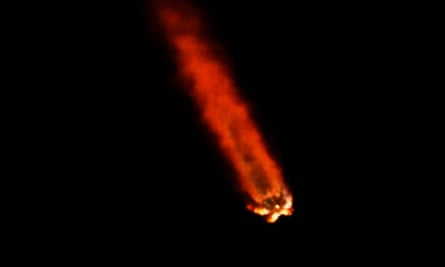Most UFOs – like the Chinese spy balloon – can be explained away. But what about the other 2%?
Sometimes they appear in the form of an orb of light, high in the sky, that seems to pass through solid objects such as trees and buildings. Sometimes it’s a strange mist that descends out of nowhere. In an increasing number of cases, an object that can’t be seen with the naked eye shows up clearly in a photographic image.
These are examples of UFOs – literally, unidentified flying objects – that are spotted in UK skies every day. In the wake of the US shooting down a suspected Chinese spy balloon, plus three other objects it has yet to identify, experts say there are going to be a lot more of these kinds of sightings. As a UFO researcher, I treat these things with scepticism and scientific rigour, but part of me hopes they will never be fully explained.
As the head of national investigations for the British UFO Research Association (Bufora), I’m one of a team of people who investigate such sightings, which are sent to us by the public at a rate of hundreds a year. Often they come as grainy mobile phone footage taken at dusk or from a moving car, but we also require witnesses to fill in a detailed form explaining what they saw, heard, felt and even smelled at the time of the event. We promise to treat sightings confidentially, objectively and with scientific rigour. In 98% of cases, we find they have a simple explanation.

Typically, when we receive a report at Bufora, I take a look and pass it on to our photographic analyst, Mark Easen. Objects most commonly turn out to be drones, aircraft (sometimes military aircraft), satellites, meteors, balloons, lanterns or birds. When Elon Musk’s SpaceX first launched its Starlink satellites in 2019, we were inundated with sightings of small pinpricks of light moving steadily across the night sky, sometimes 50 or 100 at a time. By finding out where witnesses are at the time and what airports, military bases or other facilities are nearby, we can usually identify the objects they’ve observed. It’s important to know what they’ve seen with the naked eye, because often a UFO will turn out to be a speck of dust on the camera lens, a tiny insect flying into shot or the reflection of a seatbelt buckle in a car window. First, we rule out the obvious. If it looks like a plane and flies like a plane, it’s usually a plane.
Reports follow patterns and trends that reflect the changing media landscape. In our not-too-distant past, unexplainable phenomena tended to be reported as fairies or goblins – things people saw in the folklore and mythology of the day. Now, sci-fi books and films affect the way people interpret what they have seen. There’s a particular type of sighting that we call high strangeness sightings (HSS), when someone feels they have been up close and personal with something of unknown origin – and during the 1990s, when The X-Files was hugely influential, as many as 8% of sightings reported to us were HSS. They’re usually rare, but I saw them increase again during lockdown. People were scared, and understandably so.

I became interested in space when I lived in the US in the 1970s and early 80s, where my dad was an aeronautical engineer for Nasa. But I’ve always been interested in extraordinary human experiences – things outside the boundaries of what we understand. The UFO subject embraces a huge and diverse landscape: science, religion, folklore and myth, the paranormal, neuroscience and philosophy. I’ve learned a lot about the way memory works: once you lay down an experience into long-term memory, each time you access that memory it is slightly edited. You add to it things you’ve seen, conversations you’ve had, a TV programme you saw. I never think people are foolish when they report a UFO; I’m just fascinated by the ways we interpret reality.
I’m often asked what I believe about extraterrestrial life, and whether it will ever make contact. After all, about 2% of the UFOs we hear about can’t be identified – yet. In all the years I’ve spent looking at the evidence, I have never seen any definitive proof that a UFO has been extraterrestrial in origin, but I don’t close my mind to the possibility. I’m sceptical – to do this work properly I have to be. But, as JBS Haldane wrote: “It is my suspicion that the universe is not only queerer than we suppose, but queerer than we can suppose.”
Personally, I think there will be a rational explanation for the objects that have been shot down by the US military recently. But there are still mysteries, and I think there always will be. I wonder what narratives humans will invent to explain the sightings of tomorrow, and what science fiction will come up with next. Will science and expert analysis be able to explain all of these things, eventually? I suspect not. I hope not.
-
Heather Dixon is head of national investigations for the British UFO Research Association
This article has been archived for your research. The original version from The Guardian can be found here.


